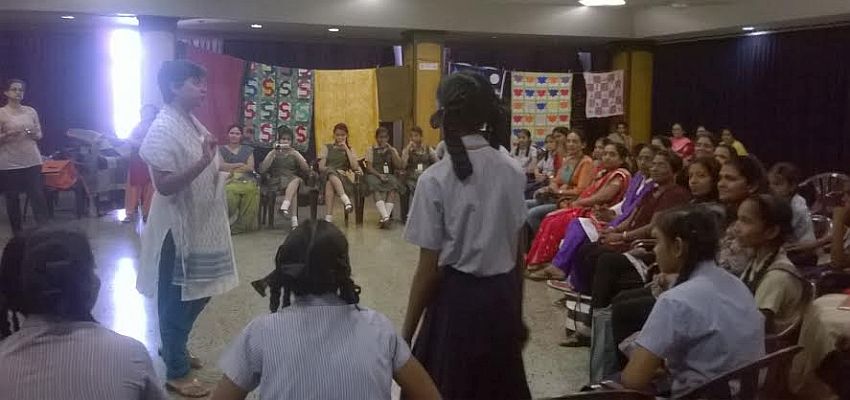
Date : January 30, 2015
Time : 0900 – 1300 Hrs.
Venue: Dempo House, Panaji, Goa
One of the central objectives of the project is sensitizing schools to local knowledge and traditional culture. So as to familiarize students to the tradition of quilt making in the state, a hands on workshop was conducted by the Naree Artisans Movement (NAM). This organisation recently worked on a unique project to document the godhadis (Goan quilt) of the state in terms of its age, cloth, motifs and designs.
At the outset, Ms. Shabana Kazi, Research Associate, TERI welcomed the participants comprising students, teachers and some parents and then explained why this workshop was being conducted under the aegis of project STARs, a joint initiative of TERI and the Dempo group of companies.
Ms. Natasha Fernandes, NAM began the session with an introduction of the godhadi, its place in the Goan cultural sphere and the need to preserve this dying craft. The relevance it had, not just as a mere covering or bedding but as we are now realising, in the various aspects which we now cherish.
- The making of a godhadi was a community effort to a half way point where the grid pattern was stitched onto the quilt.
- It was an unconscious effort at what is now called recycling. It was made of used fabric, either entirely of saris, or worn out /out grown clothes would be ripped open to form the inner layers. The patchwork variation was made from left over fabric scraps.
She then introduced the resource persons who make godhadis as a business. The four experts each gave an insight into how and why they took up making godhadis as a profession. They also encouraged the participants to work with their hands whether with needle and thread, or crochet etc. and experiment with new designs.
The working session started with the participants being divided into 4 groups. Each group had a resource person to demonstrate the art of quilting and oversee the work done by the participants.
The participants were very enthusiastic and worked diligently on their quilts. As they were working together in groups, they managed to quilt a motif each on their quilts which was commendable given the short time frame. However the technique of quilting was imparted which can also be used to make other items, and not just godhadis. There are many steps to be followed, which were explained to the participants as they progressed with their godhadis.
If the godhadi is to be made of saris (cotton voile saris) alone then, the saris should have the fall removed before being washed. When put to dry, they should be stretched properly so that they are not askew and then ironed. A godhadi traditionally is made with 5 layers of fabric, i.e almost 2 1/ 2 saris. The saris are then cut into the required length after determining that the widths are the same. Then the sari to be used for the outer (top and bottom) layer is chosen and the process begins. First, the bottom layer is stretched out on the ground ensuring that there are no creases. Then the second layer is placed on the top and the air trapped is to be removed by smoothing the fabric from the centre to the edge. This is continued for the next 3 layers ending with the top fabric being the same as the bottom layer.
Once all 5 layers are placed and the top layer seems smooth, the whole quilt has to be overturned in a synchronised movement by two persons on either end to bring the bottom layer to the top and ensure that the quilt has been laid out properly.
Then all the 4 sides are hemmed in a rough tacking stitch. The neat hemming is done at leisure.
Then the whole quilt is divided along the length into 2 parts and then into 6, 7 or 8 equal parts along the width so a grid of squares is formed. This is again tacked along all the lines drawn taking care that all the layers are stitched together. This is a time consuming and tedious process which takes quite a while when done properly.
After the entire tacking is completed, only then, one person can work on the quilt independently, tracing the designs on each square and quilting it. Traditionally the designs used were geometrical – concentric squares, circles, diamonds, hexagons or spiral. The quilting stitch is a tiny running stitch. Once the entire quilting is done, the tacking stitches are removed and the 5 layers of fabric are held together by hundreds of tiny little stitches.
The beauty of a well-made godhadi lies in the size of the stitch, the distance between two stitches and the distance between two rows of stitches, and of course the tension of the thread used, all of which should be uniform through the quilt.



